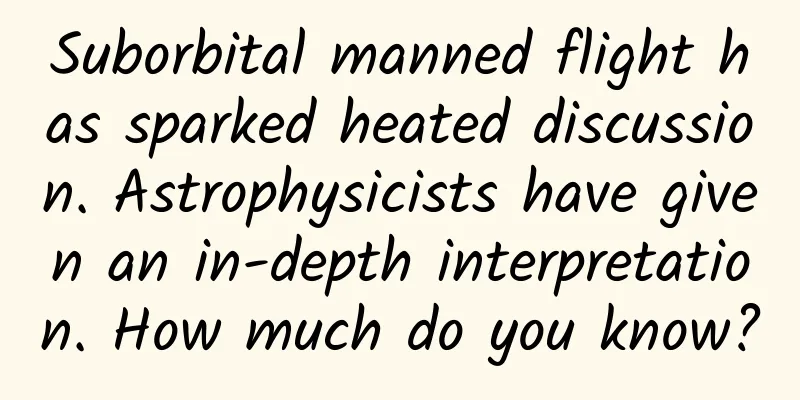Suborbital manned flight has sparked heated discussion. Astrophysicists have given an in-depth interpretation. How much do you know?

|
What is suborbital flight? (And why should we care?) The New Shepard booster lands during the NS-10 mission. (Image credit: Blue Origin) Suborbital missions made the news as the first flight by the founders of Virgin Galactic and Blue Origin, but what exactly does suborbital mean, and does the technology have other uses besides helping these billionaires scramble to get to space? Jeff Bezos, the founder of Amazon and the world's richest man, will ride and launch the New Shepard, built by his private aerospace company Blue Origin, on its first manned spaceflight, which will rise to an altitude of 62 feet (100 kilometers) before landing again on the same launch pad. British entrepreneur Richard Branson has soared to 53 feet (86 kilometers) in a rocket-powered spacecraft built by his private company Virgin Galactic. For the sake of the competition, Bezos has also touched the edge of space altitude. While admirable, both launch vehicles are very different from conventional space rockets. "The simple difference is that suborbital flights don't have the velocity to go into full orbit," said Stephen McCandless, a professor of astrophysics at Johns Hopkins University in Maryland. Orbital flight occurs when the side thrust of a spacecraft or satellite creates a thrust that perfectly counteracts the force of gravity, so that it follows an arc, mechanically continuing to fall toward the Earth but physically no longer getting close. When launched, an orbiting spacecraft initially goes vertically upward, and after passing through the thickest part of the atmosphere, it begins to tilt and increase its horizontal speed in order to generate enough thrust to stay in orbit. Achieving this goal is a challenge, though—the horizontal speed required to maintain orbit depends on altitude, and for low-Earth orbit at an altitude of 150 miles (240 kilometers), that's about 17,000 miles per hour (about 27,400 kilometers per hour). "To maintain orbital motion, you have to be traveling at about 8 kilometers per second," Stephen McCandless told Science Online. "On top of that, you have to be at a certain altitude to penetrate the atmosphere, and all of that takes energy." A rocket that wants to reach orbit but doesn't have enough power will just take a parabolic trajectory, launching in an arc and then falling back down. McCandless said that although such suborbital missions are short, passengers will still get stunning views of the Earth and experience a few minutes of weightlessness. The 15th launch of the New Shepard (NS-15 mission) took off from Launch Station 1 in West Texas. (Image from: Blue Origin) Mission accomplished, the New Shepard booster then landed and was displayed at its 15th launch site. (Image credit: Blue Origin) The New Shepard thruster is parked on the landing platform, having completed the NS-15 mission. (Image source: Blue Origin) Mission accomplished, the New Shepard crew capsule landed at a remote site in the West Texas desert. (Image credit: Blue Origin) Since the launch track has a downward force, it is basically a free fall, and the gravity acts on the passengers and the body. In simple terms, gravity pulls people and the aircraft downward together, so the local feeling is weightlessness. This is said by Cricket, a professor of astronautics at Purdue University in Indiana. For adventure enthusiasts, this is a big deal. Blue Origin and Virgin Galactic hope the market will allow them to run profitable space tourism projects. It will also provide some interesting research opportunities, Cricket added. Microgravity research has already been conducted on the International Space Station, but space lab flights are very expensive, not to mention that the equipment also needs to fight gravity and vibration to enter orbit, Cricket said. In comparison, suborbital flights cost only a fraction of the cost and can also reduce the burden on the equipment. "These travel vehicles allow us to take more modest trips to and from space," Cricket said. "In this way, tourism creates a great low-cost laboratory for scientific research." Suborbital flights can validate experiments that researchers want to explore that are usually obscure due to gravity, such as the settling or coagulation of solid particles in liquids, Cricket said. He is trying to figure out how fluids like fuel and blood behave in low gravity, and suborbital flights give him the opportunity to explore many of these possibilities. It could also be a more affordable way for them to explore space technologies and experiments before being sent on more expensive orbital flights or deep space missions. For example, it could be possible to test emergency surgical techniques in low gravity, or to conduct definitive studies on whether all the liquids in biological and chemical experiments can stay in the right place after completing the transition from rocket launch to zero gravity. "The brief period of weightlessness will be the limiting factor," Cricket said, but these flights also open up the prospect that researchers could take off with their experiments. "This really opens up a whole new area of scientific research that can't be automated." But these flights won't be used by most aerospace scientists, said McCandless, who has worked with NASA for more than 30 years on sounding rockets and also on instruments that fly suborbital flights of experiments. But those are much more expensive and disposable, and can fly as high as 435 miles (700 kilometers) above sea level. Such an altitude is necessary for a range of space physics experiments, including the kind of ultraviolet astronomy he studies. Even at 62 miles, the atmosphere is still dense enough to interfere with electromagnetic signals, so they need to stay that high for important periods of time. "I told the public to come back and talk to me when you can get to 186 miles (300 kilometers)." Still, McCandless admires the private space industry's efforts to increase the methods of spaceflight, and he sees these companies as closely similar to the early pioneers of marine aviation. "Some people think this is wasteful, but I see it as evolution," he said. "If you want to have a more robust space infrastructure, these are the steps you have to take." BY: Edd Gent FY: ASTROLILI Stargazing Chestnut If there is any infringement of related content, please contact the author to delete it after the work is published. Please obtain authorization for reprinting, and pay attention to maintaining integrity and indicating the source |
<<: You eat very little every meal, but still can't lose weight? It's mainly because you...
>>: The shocking Pillars of Creation, what is happening there?
Recommend
How can a barber shop make money with mini programs? How can a barber shop make appointments with mini programs?
Due to the impact of the epidemic, all walks of l...
February 2023 "Science" Rumor List: Is reconstituted milk "fake milk"? Does ovulation induction and egg retrieval lead to early menopause?
The list of "scientific" rumors for Feb...
If you want users to actively help you spread the word, please do these things first!
When doing operations , one of the most important...
What’s the secret to quickly gaining followers on Douyin? A must-see for operations!
The sudden outbreak of the epidemic in 2020 destr...
The country is working hard to fight fraud! The country launched an anti-fraud app
[[399563]] I don't know if you have noticed t...
10 common misunderstandings about operations!
In writing this article, I would like to clarify ...
The battle for product placement in the chicken-eating game has begun. Which brand is the hidden chicken-eating king?
I believe everyone must have seen JD.com’s Double...
How does Baidu bidding analyze the market?
Before bidding analysis, you should first pay att...
The most searched! This ice cream doesn't melt even if it's left at 31℃ for an hour?
In recent days "Ice cream assassin" has...
Why is Android development the most sought-after?
What skills do you need to become an Android deve...
One article is enough for the year-end marketing plan of wine promotion
How to promote alcoholic products? An article wil...
Look! Here is an analysis of the advertising placement of Qutoutiao!
As a rising star of Toutiao, advertisers certainl...
Dolphin: What just got into my head?
Dolphins are very intelligent and highly social a...
Should I buy an air-cooled or water-cooled CPU cooler for the start of the school year?
The new semester is coming, and new students are ...
66 Douyin professional terms that Douyin operators must know
Entering 2020, Douyin has accelerated its pace of...









